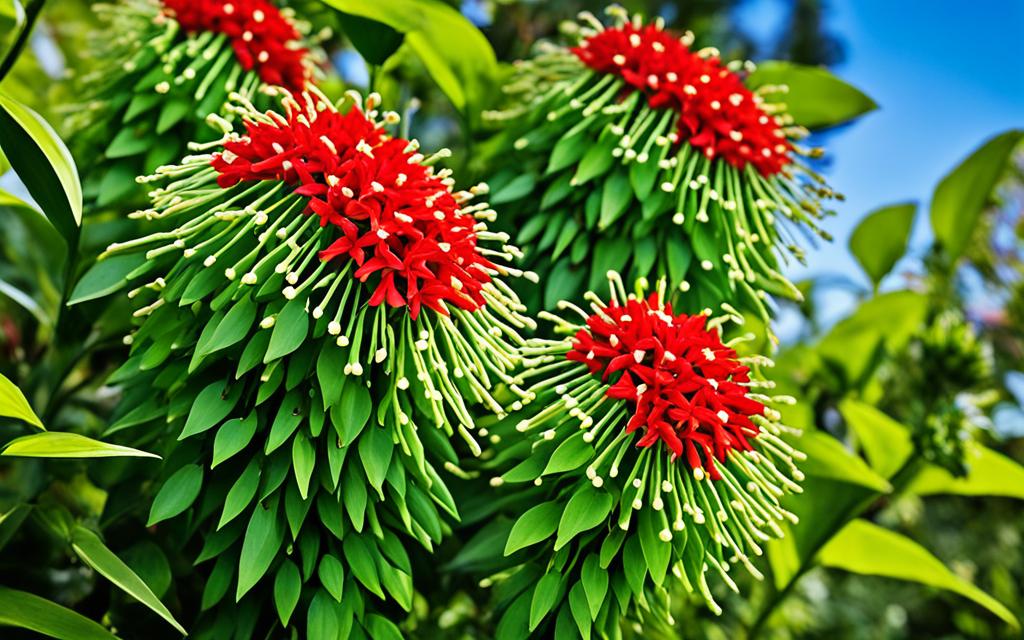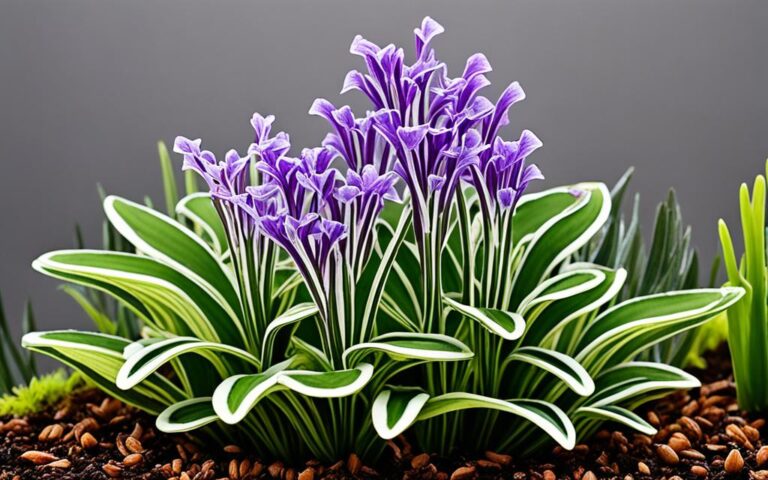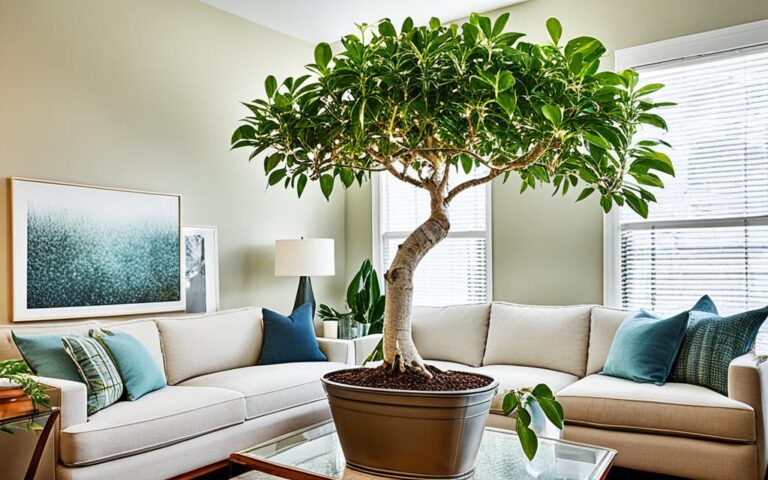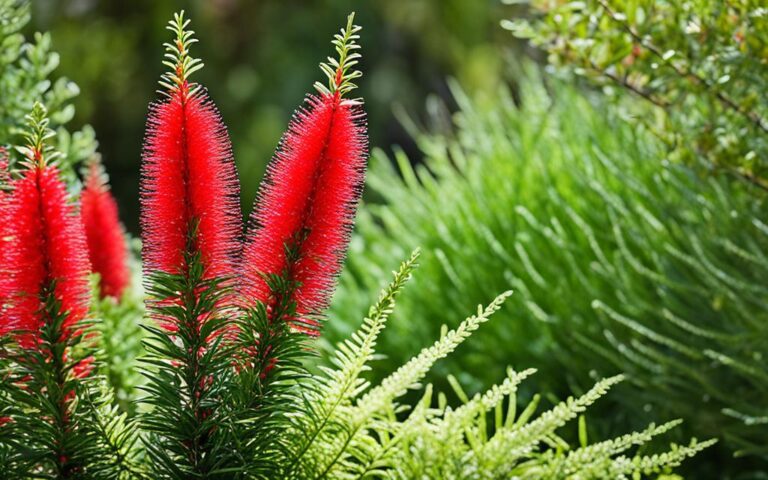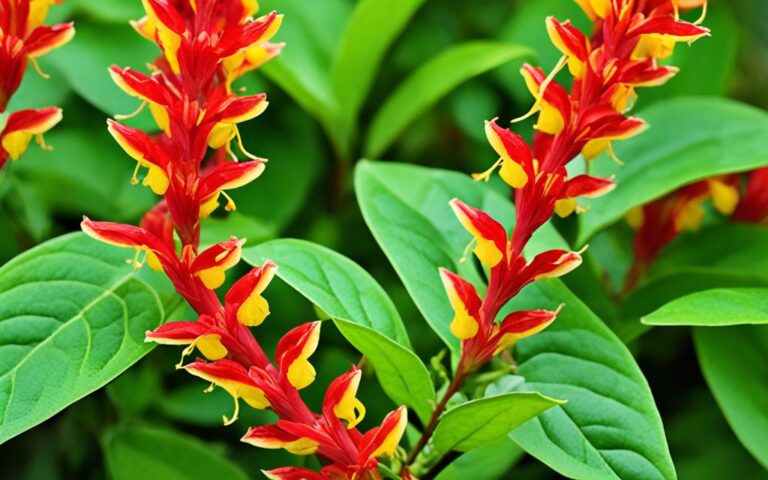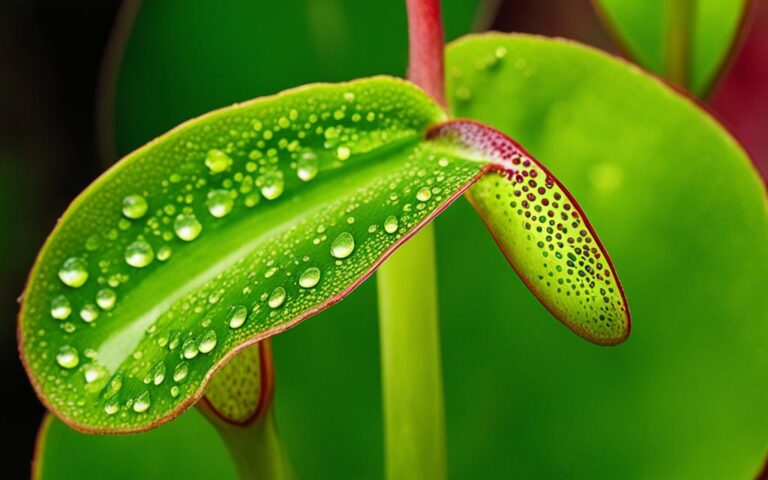Firecracker Plant: Vibrant Beauty for Your Garden
Did you know the firecracker plant, known as Russelia equisetiformis, won the Royal Horticultural Society’s Award of Garden Merit? This vibrant shrub brings color and charm to any garden. It comes from Mexico and Guatemala, known for its bright red flowers that look like fireworks.
If you love gardening or are just starting, the firecracker plant is a must-have. It thrives in the sun and is great for many places, like landscapes, containers, and even inside your home. It’s perfect for different growing conditions.
Key Takeaways
- The firecracker plant is a vibrant and versatile shrub that adds a burst of color to any garden.
- It is known for its characteristic cascading stems of bright red, tubular flowers that resemble a burst of fireworks.
- The firecracker plant has received the prestigious Award of Garden Merit from the Royal Horticultural Society, highlighting its beauty and low-maintenance needs.
- It is a popular choice for landscapes, container plantings, and even indoor houseplants, making it a versatile addition to any outdoor or indoor space.
- The firecracker plant is native to Mexico and Guatemala, adding a touch of tropical flair to any garden.
Introduction
The firecracker plant, also known as the Mexican Firecracker, is a stunning perennial. It captivates the senses with its vibrant floral displays. Its bright red, tubular flowers look like fireworks, making the garden dramatic and eye-catching.
This firecracker plant is not only beautiful but also attracts hummingbirds and butterflies. It adds natural beauty and wildlife to any outdoor space.
A Captivating Addition to Any Garden
The firecracker plant’s vibrant charm and easy care make it a favorite among gardeners. It’s great for enhancing landscapes or adding color to containers. It grows about 3 feet tall and wide, fitting well in full sun to partial shade.
The firecracker plant has long-lasting, attractive cascading flowers in red, pink, orange, and yellow. They bloom all season but don’t have a scent. Their bright colors and unique shape stand out in any garden.
Botanical Overview
The firecracker plant, known as Russelia equisetiformis, is a stunning member of the Plantaginaceae family. It’s a perennial evergreen shrub from Mexico and Guatemala, loving warm climates all year. It grows 3-5 feet tall and 5-6 feet wide, making it a great choice for gardens.
Taxonomy and Classification
The firecracker plant is part of the Plantaginaceae family. This family has about 1,900 species across 94 genera. It’s known for its beautiful and useful plants, with the firecracker plant being a top pick.
Common Names and Varieties
- It’s also called red ginger, red hot poker, torch lily, flame flower, tricolored sage, and hummingbird plant.
- There are many cultivars and varieties, each with unique traits. Some favorites include ‘Lemon Falls’ with bright lemon-yellow stems, ‘Tangerines Falls’ with beautiful tangerine stems, and ‘Elmo’s Firecracker’ with fiery red-orange stems.
The firecracker plant’s many names and varieties show its beauty and versatility. It’s a favorite in gardens everywhere.
Vibrant Floral Displays
The firecracker plant is known for its bright flowers that grab your attention. These flowers come in fiery colors like red, pink, orange, and yellow. They look like an explosion of color and texture. The flowers grow down from the stems, making any garden or landscape look more interesting.
The plant’s green leaves make its flowers stand out even more. These flowers are not just pretty; they also draw in hummingbirds and butterflies. This adds more beauty and life to your garden.
The firecracker plant flowers all year round, bringing color to your garden. It’s a favorite spot for hummingbirds because of the nectar it offers. Plus, it’s easy to care for because it’s drought resistant and has few pests.
“The firecracker plant’s blooms are a true celebration of nature’s artistry, captivating all who behold them.”
People think the firecracker plant can clean the air, which is good for health. It’s also used in folk medicine for its healing powers. This plant is important in many cultures.
Firecracker Plant: An Irresistible Nectar Source
The firecracker plant’s bright flowers are a treat for hummingbirds and butterflies. They offer a sweet nectar that draws in many pollinators. This makes the garden a lively place for wildlife enthusiasts to watch.
Adding the firecracker plant to your garden helps these pollinators thrive. It’s easy to grow, can handle drought, and fits well in different light. This makes it perfect for gardeners who want to attract hummingbirds and butterflies.
The vibrant red and orange flowers of the firecracker plant are a hit with hummingbirds. Planting it with other flowers like Agastache, Salvia, Kniphofia, and Penstemon makes your garden a hotspot for wildlife.
“The firecracker plant transformed my garden into a vibrant oasis, alive with the fluttering of hummingbirds and butterflies feeding on its irresistible nectar.”
By taking care of the firecracker plant, you connect more with nature. You’ll see how these pollinators and the plant interact. Let the firecracker plant turn your garden into a wildlife attraction and enjoy the joy it brings.
Cultural Significance and Symbolism
The firecracker plant, or Mexican Firecracker, is very important in Mexican culture. Its bright flowers bring excitement and happiness. They are often seen at celebrations, adding color and joy.
This plant truly captures the spirit of celebration and happiness. It’s a symbol of the joy in Mexican culture.
A Plant Steeped in Mexican Heritage
The firecracker plant is more than just pretty. It connects us to Mexico and Guatemala’s rich history and stories. Each flower tells a part of the cultural heritage.
Symbolism of Celebration and Joy
The plant’s bright colors and beautiful flowers are linked to the happiness of Mexican celebrations. It’s seen at festivals and family events, symbolizing the lively spirit of these moments. The firecracker plant truly represents the heart of Mexico.
“The firecracker plant is more than just a beautiful flower – it is a living embodiment of the rich cultural heritage and joyous spirit of Mexico.”
Growing Requirements
The firecracker plant (Russelia equisetiformis) loves sunny spots with good drainage. It’s from Mexico and Guatemala. It needs full sun most of the day but can handle some shade in very hot places.
Ideal Light and Temperature Conditions
Firecracker plants do well in warm places, just like their tropical home. They can handle cold as low as 41°F (5°C). But they grow best in USDA zones 9a to 11b, reaching 2 to 4 feet tall and 3 to 5 feet wide.
Soil Preferences and Drainage
- They need well-draining, rich soil like sandy or loamy types.
- Good drainage stops diseases by keeping the roots dry.
- They can grow in various soils, including clay, as long as it drains well.
By giving the firecracker plant the right growing conditions, light requirements, temperature, soil, and drainage, gardeners can make it thrive. This creates a perfect setting for its bright flowers and full growth.
“The firecracker plant is a true showstopper, with its cascading, fiery blooms that seem to explode with color and texture.”
Watering and Fertilization Needs
The firecracker plant is a gem that loves minimal watering and nutrients. During the growing season, it needs regular watering. Make sure the soil gets moisture but avoid waterlogging. In the colder months, cut back on watering.
For fertilizing, the firecracker plant doesn’t need much. A light, slow-release fertilizer in the growing season is enough. But, be careful not to overfeed it, especially in wet soil. This can cause too much growth, making it vulnerable to pests and diseases.
| Watering Needs | Fertilization Requirements |
|---|---|
|
|
By knowing the watering and fertilization needs of the firecracker plant, gardeners can help it grow well. It becomes a beautiful, drought-tolerant plant with little work.
Propagation Methods
The firecracker plant is easy to spread through seeds and dividing the root ball. This lets gardeners fill their areas with its bright flowers and green leaves.
From Seeds
Start by planting firecracker seeds in a potting mix that drains well. Put the seed pot in a spot that gets some shade to full sun. With the right care, seeds will grow, and you can move the young plants later when they have strong roots.
Dividing and Transplanting
- Firecracker plants can be easily spread by dividing the root ball in late winter or early spring, right before they start growing.
- This method means taking the root system apart into sections, making sure each has its own stems.
- Then, you can put these sections in new pots or directly in the garden. This is a simple way to grow more firecracker plants.
It’s important to take good care of the firecracker plants when you’re starting new ones from seeds or division. By doing so, you can enjoy this beautiful plant in your outdoor areas.
| Propagation Method | Time Frame | Success Tips |
|---|---|---|
| Stem Cuttings | 2-6 weeks |
|
| Division | 1-2 weeks |
|
| Air Layering | 6-12 weeks |
|
Using these methods, gardeners can easily spread the firecracker plant in their outdoor areas.
Maintenance and Pruning
The firecracker plant (Russelia equisetiformis) needs little upkeep but pruning is key to keep it looking great. Prune it in late winter or early spring, right before it starts growing again.
Focus on cutting dead or damaged stems when you prune. This makes the plant look neat and encourages new growth. You can also trim it to keep its cascading shape.
Proper pruning is vital for the firecracker plant’s best flowering and growth. Use pruning shears for most cuts, loppers for big branches, and hand saws for thick ones. Always use clean tools to avoid spreading diseases.
Removing spent flowers, or deadheading, is also important. It helps the plant focus on making more flowers instead of seeds. This makes it bloom longer.
| Maintenance Task | Best Time | Reason |
|---|---|---|
| Pruning | Late winter or early spring | Promotes healthy new growth and maintains the plant’s shape |
| Deadheading | Throughout the growing season | Extends the flowering period by redirecting energy to new blooms |
| Fertilization | Every two weeks during the growing season | Provides essential nutrients for robust growth and abundant flowers |
By sticking to these tips, gardeners can keep the firecracker plant looking great and interesting.
Companion Planting Strategies
The firecracker plant’s bright colors and lush leaves make it great for garden companions. By picking plants with matching or different colors and textures, gardeners can make their gardens look amazing. This approach makes the garden more beautiful and balanced.
Complementary Color Palettes
The firecracker plant looks great with plants that have contrasting or similar colors. Try it with yellow flowers like gold lantana, angelita daisy, or yellow bells for a bold look. Or, pair it with plants like blue mist shrub or purple coneflower for a calming effect.
For a simple and beautiful garden, mix the firecracker plant with succulents like artichoke agave, elephants food, or lady’s slipper. This mix not only looks great but also helps the garden survive with less water.
| Complementary Plants | Color Palette |
|---|---|
|
Warm, vibrant hues |
|
Cool, soothing tones |
|
Drought-tolerant, low-maintenance |
By pairing the firecracker plant with other plants, gardeners can make their gardens look stunning. This approach highlights the beauty of this special plant.
Pest and Disease Management
The Firecracker plant is usually tough and easy to care for. But, it can face pests and diseases if not looked after well. Spider mites are a big problem, especially indoors or in dry places. Keep an eye on your plant and act fast if you see any pests.
Other pests like scale insects, fungus gnats, fruit flies, mealybugs, aphids, whiteflies, and thrips can harm the plant too. These pests can damage the leaves and hurt the plant’s health. You might need to use insecticides like neem oil or insecticidal soap to get rid of them.
Fungal diseases can also trouble the Firecracker plant. This happens if the soil doesn’t drain well or if the plant gets too much water. Make sure the soil drains well and don’t overwater to avoid these problems.
By being careful and dealing with pests or diseases right away, you can keep your Firecracker plants healthy and bright.
| Pest or Disease | Symptoms | Treatment |
|---|---|---|
| Spider Mites | Webbing on leaves, stippling, and discoloration | Neem oil, insecticidal soap |
| Scale Insects | Bumps on stems and leaves | Alcohol swabs, horticultural oil |
| Fungus Gnats and Fruit Flies | Small dark insects hovering around soil | Hydrogen peroxide soil drench, sticky traps |
| Mealybugs | White, fluffy masses on plants | Alcohol and soapy sprays, quarantine affected plants |
| Aphids, Whiteflies, Thrips | Foliage damage, sap-sucking | Insecticidal soap, neem oil |
Checking your plants often and using good pest management practices are key to keeping Firecracker Plants looking great.
Firecracker Plant in Containers
The firecracker plant is perfect for container gardening and hanging baskets. It loves the sun and has cascading stems that spill over the edges. This makes any patio, balcony, or entryway bright and colorful.
This versatile plant fits in many containers, from big to small. It’s great for outdoor spaces, adding beauty with its fiery blooms. With the right care and sunlight, it will keep your garden lively all season.
Container and Hanging Basket Considerations
Choosing the right pot or basket is key for the firecracker plant. It needs humus-rich, light, moist, and well-draining soil. Big containers are better for this plant because they help it spread its roots.
| Container Size | Plant Spread | Watering Frequency |
|---|---|---|
| Small Pot (6-8 inches) | 1-2 feet | Every 1-2 weeks |
| Medium Pot (10-12 inches) | 2-3 feet | Every 2-3 weeks |
| Large Planter (14+ inches) | 3-4 feet | Every 3-4 weeks |
Hanging baskets are great for the firecracker plant’s cascading stems. They need more water, especially when it’s hot and dry, to stay healthy.
The firecracker plant is great for gardeners who want color and texture. It fits many containers and looks beautiful on patios, balconies, or by entryways.
Landscape Design Ideas
The firecracker plant is a great choice for landscape design. Its cascading stems and bright blooms can be a focal point in the garden. Grouping several plants together makes a bold, eye-catching display.
This plant loves the sun and can grow in many garden spots. By placing it thoughtfully, gardeners can make their outdoor areas more interesting and unified.
Firecracker Plants as Focal Points
Putting a firecracker plant in a key spot makes a beautiful focal point. Its stems and blooms catch the eye, perfect for a garden bed or border. Add things like low-growing groundcovers or ornamental grasses to make it even more striking.
Firecracker Plants in Mass Plantings
Planting several firecracker plants together makes a bold statement. It’s great for a backdrop, along a path, or around a seating area. The plant’s cascading stems and bright colors turn a garden into a colorful masterpiece.
Using the firecracker plant in your garden ideas can make your outdoor space more beautiful. It highlights the plant’s beauty and charm.
Culinary and Medicinal Uses
The firecracker plant, known as Russelia equisetiformis, is mainly valued for its looks. But it also has uses in cooking and medicine.
In some cultures, the plant’s bright flowers add color and a spicy taste to salads or as a garnish. You can also suck out the sweet nectar from the flowers for a cool snack.
Parts of the firecracker plant are used in traditional medicine too. They have anti-inflammatory properties that help reduce swelling and ease irritation. Studies on its medicinal uses have been done in many countries, with Nigeria leading the way.
But, not all parts of the plant are safe to eat. It’s important to know what you’re doing to avoid any problems. Always talk to a doctor before using the firecracker plant for health reasons, as it can be risky.
| Culinary Uses | Medicinal Uses |
|---|---|
|
|
The firecracker plant is known for its bright looks. But it’s also useful in cooking and medicine. This makes it a valuable plant in many cultures.
Conclusion
The firecracker plant, or Russelia equisetiformis, is a bright and flexible addition to any garden. Its cascading stems with fiery red flowers attract hummingbirds and butterflies. It loves the sun and well-drained soil, making it easy for gardeners.
This plant is important in Mexican culture, symbolizing celebration and joy. It fits well in landscapes, containers, or indoors, adding a burst of beauty and charm. By knowing how to care for it, gardeners can enjoy its beauty and value.
In summary, the firecracker plant stands out with its bright colors, easy care, and help to pollinators. Its versatility and cultural importance make it a top choice for anyone wanting a beautiful garden.
